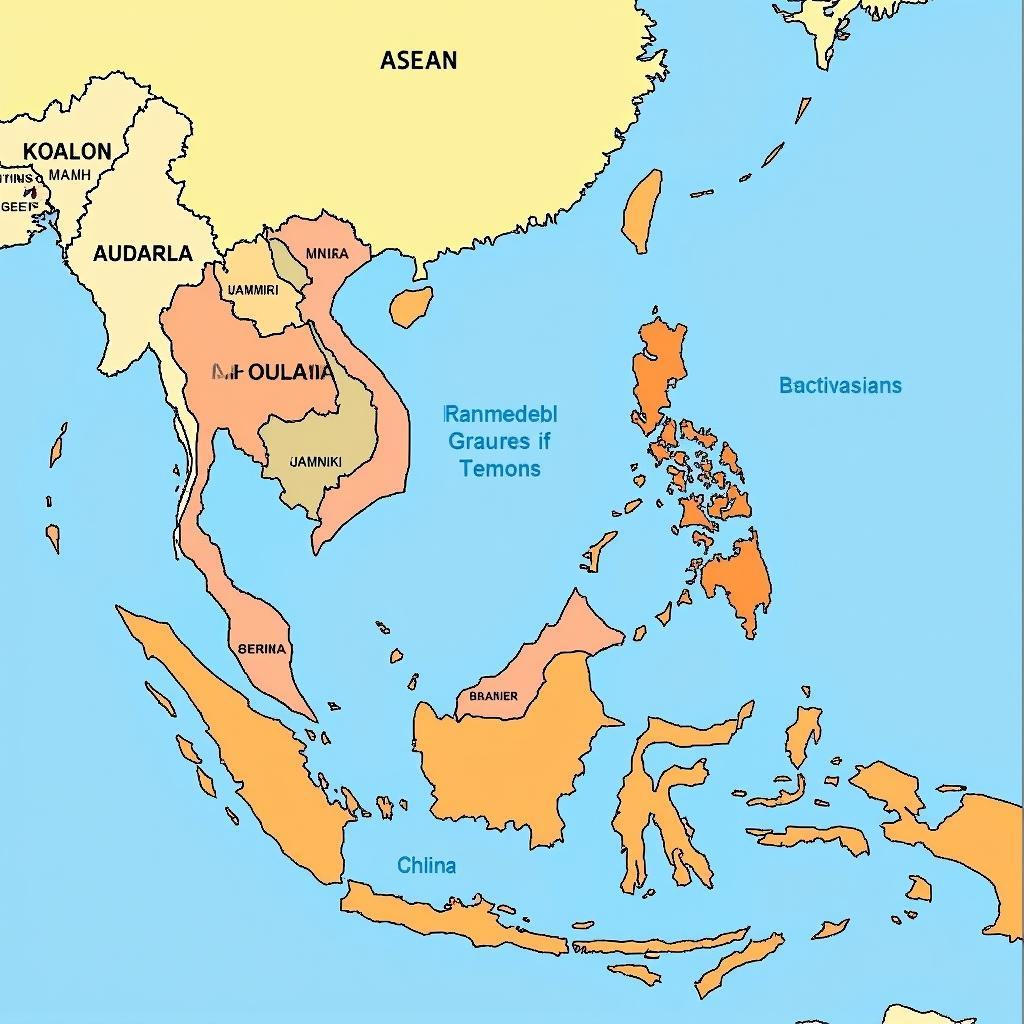The Association of Southeast Asian Nations (ASEAN) has become a cornerstone of regional stability and economic growth. Understanding the ASEAN origin is crucial to grasping the complexities and potential of this dynamic intergovernmental organization. This article explores the historical context, founding principles, and evolving role of ASEAN in the global landscape. We will delve into the key milestones that shaped its trajectory, from its inception to its present-day influence.
The Genesis of ASEAN: From Cold War Tensions to Regional Cooperation
 ASEAN formation in Cold War context
ASEAN formation in Cold War context
The ASEAN origin story is inextricably linked to the tumultuous backdrop of the Cold War. The region was grappling with political instability, communist insurgencies, and the looming threat of superpower intervention. Amidst this volatile climate, five nations – Indonesia, Malaysia, the Philippines, Singapore, and Thailand – recognized the imperative for regional solidarity. On August 8, 1967, they signed the Bangkok Declaration, marking the official birth of ASEAN. This pivotal document laid the foundation for a collaborative approach to regional security, economic development, and social progress. You can find more information about the original members here: 10 original members of asean.
The Bangkok Declaration: Cornerstone of ASEAN Origin and Principles
The Bangkok Declaration enshrined the core principles that would guide ASEAN’s trajectory. These principles emphasized respect for national sovereignty, non-interference in internal affairs, peaceful settlement of disputes, and renunciation of the threat or use of force. These tenets, rooted in the shared desire for regional stability, provided a framework for navigating the complex geopolitical landscape. The Declaration also stressed the importance of economic, social, and cultural cooperation, recognizing that these were essential pillars for building a prosperous and resilient Southeast Asia.
What were the primary goals outlined in the Bangkok Declaration?
The Bangkok Declaration primarily aimed to accelerate economic growth, social progress, and cultural development in the region. It also sought to promote regional peace and stability through abiding respect for justice and the rule of law in the relationship among countries in the region and adherence to the principles of the United Nations Charter.
Expanding Horizons: The Evolution of ASEAN Membership and Mandate
Over the decades, ASEAN has expanded its membership to encompass all ten Southeast Asian nations. Brunei Darussalam, Vietnam, Laos, Myanmar, and Cambodia subsequently joined the organization, solidifying its position as the premier regional forum. This expansion not only broadened its geographical reach but also diversified its cultural tapestry. ASEAN’s mandate has also evolved to address emerging challenges, including transnational crime, environmental degradation, and the rise of non-state actors. Learn more about the rules of origin within the ASEAN framework at asean atiga rules of origin.
ASEAN’s Economic Integration: Fostering Growth and Connectivity
ASEAN’s economic integration initiatives have been instrumental in driving regional prosperity. The ASEAN Free Trade Area (AFTA) has significantly reduced tariffs and non-tariff barriers, facilitating the free flow of goods and services. This has stimulated trade and investment, contributing to the region’s remarkable economic growth. Furthermore, ASEAN has actively pursued deeper economic integration through initiatives like the ASEAN Economic Community (AEC), which aims to create a single market and production base.
How has ASEAN contributed to economic growth in Southeast Asia?
ASEAN has played a pivotal role in promoting economic growth by fostering regional integration, reducing trade barriers, attracting foreign investment, and enhancing regional competitiveness. These efforts have created a more dynamic and interconnected economic landscape in Southeast Asia.
ASEAN’s Role in the 21st Century: Navigating a Complex World
In the 21st century, ASEAN faces a myriad of complex challenges, from geopolitical rivalries to climate change and the rapid pace of technological advancement. The organization has sought to strengthen its mechanisms for conflict resolution and crisis management, recognizing the importance of maintaining regional stability in an increasingly interconnected world. ASEAN also plays a crucial role in promoting multilateralism and regional cooperation, serving as a bridge between major powers. Check out more about the word etymology of “ASEA” at asea etymology. You may be also interested in ase culture keto bread original 100 paleo. Additionally, learn about asea gta 5 оригинал.
Conclusion: The Enduring Legacy of ASEAN Origin
The ASEAN origin story is a testament to the power of regional cooperation in overcoming adversity and building a shared future. From its humble beginnings amidst Cold War tensions, ASEAN has evolved into a vital force for peace, stability, and prosperity in Southeast Asia. As the organization navigates the complexities of the 21st century, its founding principles and commitment to regionalism will continue to shape its trajectory and contribute to a more integrated and resilient Southeast Asia.
FAQ
-
What does ASEAN stand for?
ASEAN stands for the Association of Southeast Asian Nations. -
When was ASEAN founded?
ASEAN was founded on August 8, 1967. -
What are the main objectives of ASEAN?
The main objectives of ASEAN are to promote regional peace and stability, accelerate economic growth, social progress, and cultural development. -
How many members are there in ASEAN?
There are ten member states in ASEAN. -
What is the ASEAN Charter?
The ASEAN Charter is a legally binding document that provides a formal framework for ASEAN’s cooperation and integration efforts. -
How does ASEAN promote economic cooperation?
ASEAN promotes economic cooperation through initiatives like the ASEAN Free Trade Area (AFTA) and the ASEAN Economic Community (AEC). -
What is ASEAN’s role in regional security?
ASEAN plays a crucial role in regional security through dialogue, confidence-building measures, and conflict resolution mechanisms.
When you need assistance, please contact us at Phone Number: 0369020373, Email: aseanmediadirectory@gmail.com Or visit us at: Ngoc Lien Village, Hiep Hoa, Bac Giang, Vietnam. We have a 24/7 customer service team.